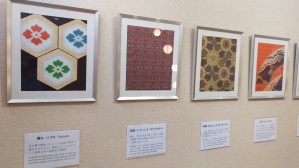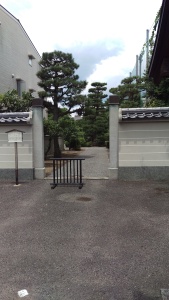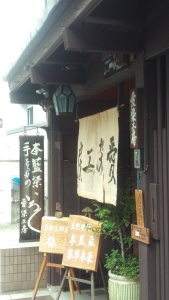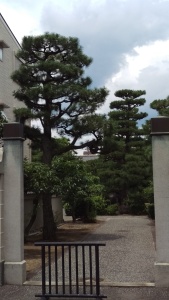
The Lonely Planet Guide did not make the Nishijin Textile Centre sound especially alluring, and nor did some of the promotional materials. I decided to go anyway.

There were some amazing fabrics and garments on display. The display itself was relatively small, though lovely–but the Centre was very popular–and clearly not because of the single room of displays upstairs which I had all to myself. The main attraction seemed to be the souvenir shop, which was full of tourists from all round the world the day I was there. It had a wide range of items made with and decorated in beautiful Japanese fabrics. There was also a working Jacquard loom, with a weaver demonstrating its operation on the main floor of the building, and with some explanatory signage about the long history of interaction between China and Japan in the matter of weaving.

I took just two photos inside the building before seeing the signs banning photography and desisting.

After the Nishijin Textile Centre I went to the Archaeological Museum, just a short walk away. It was a small but impressive place, apparently run by a small group of enthusiasts. Signs were mostly translated into English, which was a boon to me, so I spent a long time reading all I could. I had already been to Nijojo Mae Castle at this point, and so had questions I was trying to answer. The translations here were informative about the archaeology of Kyoto, but they did also suggest some of the ways Japanese and English differ. I puzzled for quite a while over a ceramic object labelled as a “pillow”, wondering how something so small could be a pillow for anyone. Eventually I realised this might be a literal translation of what in English would be a stopper or a lid for a jar or jug.

Next I went to the Aizenkobo Indigo Studio, where master indigo dyer Kenichi Utsuki lives and works. It turned out that I had arrived at a time when he was not dyeing. Rather, I arrived and was the only customer in the studio. Kenichi Utsuki showed me hos beautiful dyeing and the studio, complete with high end fashion garments and special orders hanging on racks. Friends, I was overcome with shyness at having the master dyer (and his wife) attending only to me, and deeply awkward about my lack of Japanese. I tried to explain that I understood that he was an internationally famous dyer and that his work was complex, built on an extensive Japanese tradition (using only Japanese indigo and fermentation methods)–I am not sure that I succeeded in communicating this. But I did spend quite some time with Kenichi Utsuki listening to him about his lifetime’s work and leafing though his photo albums, looking around in awe. Even the house itself was rather amazing and had been in his family for generations. I could not bring myself to ask if I could take photos and so I have only the front door to show you and you will have to follow the link to see more. I came home with a beautiful furoshiki and some sashiko thread dyed virtually black-blue.

Afterward I walked for a long distance. In Kyoto I was forever thinking that I wouldn’t walk as far as yesterday and would just catch a bus because of the heat. but then I was constantly overcome by wanting to see something lying ahead, or wondering what was around the corner. I was forever passing beautiful plants and unfamiliar styles of building. So I just had to keep walking and looking!


This is the stuff of dreams – what beautiful creations. I marvel at their skills and quality (I checked Aizenkobo Indigo’s product gallery). Thanks for sharing
LikeLiked by 1 person
Utterly amazing.
LikeLiked by 1 person
Geisha girls would sleep on ceramic pillows to keep their amazing hairdos intact – perhaps that is what you saw? A Takamakura?
LikeLiked by 1 person
Thank you for this information! I doubt it, because it was only a centimetre or two across (a doll pillow?). But that does rather explain how something ceramic could be thought of as a pillow at all!
LikeLiked by 1 person
I know both places well and along with friends have also experienced the kindness of the Utsuki family, when their son showed us to a local restaurant where we could get some lunch and then helped us with ordering as well. Nishijin has a variety of activities depending on what is scheduled. I have seen obi weaving and brush-making there at different times. Nearby and well worth a visit is the Raku Museum with it’s display of ceramics (a small museum but beautiful formed!).
LikeLiked by 1 person
My friend went to the Raku museum on a day when I just couldn’t go any further, so I missed it. But yes–the Utsuki family were just so kind and generous and the dyeing just extraordinary.
LikeLike
You are so generous in sharing this adventure…not just in a couple of pics but in luxurious detail… thank you.
LikeLiked by 1 person
Thanks Rebecca: I was a bit worried that it would make boring reading so this feedback is extra welcome…
LikeLike